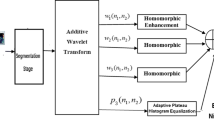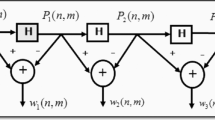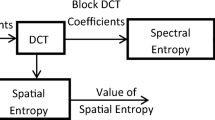Abstract
This paper presents new three proposed approaches for enhancement of Infrared (IR) night vision images. The first approach is based on merging gamma correction with the Histogram Matching (HM). The second approach depends on hybrid gamma correction with Contrast Limited Adaptive Histogram Equalization (CLAHE). The third approach is based on a trilateral enhancement that the IR images pass through three stages: segmentation, enhancement and sharpening. In the first stage, the IR image is divided into segments based on Optimum Global Thresholding (OTSU) method. The second stage, which is the heart of the enhancement approach, depends on Additive Wavelet Transform (AWT) to decompose the image into an approximation and details. Homomorphic enhancement is performed on the detail components, while Plateau Histogram Equalization (PHE) is performed on the approximation plane. Then, the image is reconstructed and subjected to a post-processing high pass filter. Average gradient, Sobel edge magnitude, entropy and spectral entropy has been used as quality metrics for assessment the three proposed approaches. It is clear that the third proposed approach gives superior results to the two proposed approaches point view the quality metrics. On the other hand, clear that the third proposed approach takes long computation time in the implementation with respect to the two proposed approaches. The first proposed approach gives better results to the two proposed approaches from the computation time perspective.
















Similar content being viewed by others
References
Affonso AA, Rodrigues ELL, Veludo de Paiva MS (2017) High-boost weber local filter for precise eye localization under uncontrolled scenarios. Pattern Recogn Lett 102:50–57. https://doi.org/10.1016/j.patrec.2017.12.015
Alirezanejad M, Saffari V, Amirgholipour S, Sharifi AM (2014) Effect of Locations of using High Boost Filtering on the Watermark Recovery in Spatial Domain Watermarking. Indian J Sci Technol 7(4):517–524
Ashiba HI, Mansour HM, Ahmed HM, El-Kordy MF, Dessouky MI, El-Samie FEA (March 2018) Enhancement of infrared images based on efficient histogram processing. Wirel Pers Commun 99(2):619–636
Ashiba HI, Mansour HM, Ahmed HM, El-Kordy MF, Dessouky MI, Zahran O, El-Samie FEA (May 2019) Enhancement of IR images using histogram processing and the Undecimated additive wavelet transform. Multimed Tools Appl 78(9):11277–11290
Ashiba MI, Tolba MS, El-Fishawy AS, Abd El-Samie FE (2019) Gamma correction enhancement of infrared night vision images using histogram processing. Multimed Tools Appl 78(19):27771–27783
Ashiba MI, Tolba MS, El-Fishawy AS, Abd El-Samie FE (2019) Hybrid enhancement of infrared night vision images system. Multimed Tools Appl 79:6085–6108. https://doi.org/10.1007/s11042-019-7510-y
Bai X, Liu H (2017) Edge enhanced morphology for infrared image analysis. Infrared Phys Technol 80:44–57
Cai H, Zhuo L, Chen X, Zhang W (2019) Infrared and visible image fusion based on BEMSD and improved fuzzy set. Infrared Phys Technol 98:201–211
Chen Y, L Yang, Z Zeng, Q Ren, X Xu, Q Zhang, T Xu, S Ouyang (2017) “Degradation in LED night vision imaging and recovery algorithms”, Optik - International Journal for Light and Electron Optics, https://doi.org/10.1016/j.ijleo.2017.05.079
Deepa S, Bharathi VS (2013) Efficient ROI segmentation of Digital Mammogram images using Otsu’s N thresholding method. Journal of Automation and Artifical Intelligence 1(2) ISSN: 2320–4001
Gade R, Moeslund TB (2014) Thermal cameras and applications: a survey. Mach Vis Appl 25(1):245–262
Gundogdu E (2015) Comparison of infrared and visible imagery for object tracking: toward trackers with superior IR performance. In: CVPR Workshops, Proceedings of the IEEE Conference on Computer Vision and Pattern
Höglund J, Mitkusa M, Olssona P, Linda O, Drewsa A, Blochc NI, Kelbera A, Strandh M (2019) Owls lack UV-sensitive cone opsin and red oil droplets, but see UV light at night: retinal transcriptomes and ocular media transmittance. Vis Res 158:109–119
Jung J and J Gibson (2006) “The interpretation of spectral entropy based upon rate distortion functions,” in IEEE International Symposium on Information Theory, pp. 277–281
Kong X, Liu L, Qian Y, Wang Y (2019) Infrared and visible image fusion using structure-transferring fusion method. Infrared Phys Technol 98:161–173
Otsu N (1979) A threshold selection method from gray-level histograms. IEEE Transactions on Systems, Man & Cybernatics 9(1):62–66
Qi W, Han J, Zhang Y, Bai L (2016) Infrared image enhancement using cellular automata. Infrared Phys Technol 76:684–690
Saad MA, Bovik AC, Charrier C (2012) Blind image quality assessment: a natural scene statistics approach in the DCT domain. IEEE Transaction on Image Processing 21(8):3339–3352
Torabi A, Masse G, Bilodeau G-A (2012) An iterative integrated framework for thermal-visible image registration, sensor fusion, and people tracking for video surveillance applications. Comput Vis Image Underst 116(2):210–221
Wang J, Peng J, Feng X, He G, Fan J (2014) Fusion method for infrared and visible images by using non-negative sparse representation. Infrared Phys Technol 67:477–489
Wu Z ,N Fuller,D Theriault, M Betke (n.d.) ” A Thermal Infrared Video Benchmark for Visual Analysis”, http://www.vcipl.okstate.edu/otcbvs/bench/
Zhang S, Li P, Xu X, Li L, Chang CC (2018) No-Reference Image Blur Assessment Based on Response Function of Singular Values. Symmetry 10(304):2–15
Zhao J, Cui G, Gong X, Zang Y, Tao S, Wang D (2017) Fusion of visible and infrared images using global entropy and gradient constrained regularization. Infrared Phys Technol 81:201–209
Zhu P, X Ma, Z Huang (2017) ”Fusion of infrared-visible images using improved multi-scale top-hat transform and suitable fusion rules”, Infrared Physics & Technology, https://doi.org/10.1016/j.infrared.2017.01.013
Author information
Authors and Affiliations
Corresponding author
Additional information
Publisher’s note
Springer Nature remains neutral with regard to jurisdictional claims in published maps and institutional affiliations.
Rights and permissions
About this article
Cite this article
Ashiba, H.I., Ashiba, M.I. Super-efficient enhancement algorithm for infrared night vision imaging system. Multimed Tools Appl 80, 9721–9747 (2021). https://doi.org/10.1007/s11042-020-09928-w
Received:
Revised:
Accepted:
Published:
Issue Date:
DOI: https://doi.org/10.1007/s11042-020-09928-w




